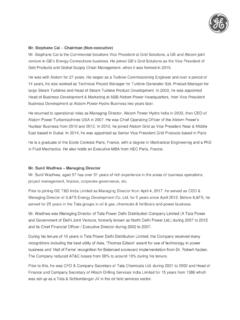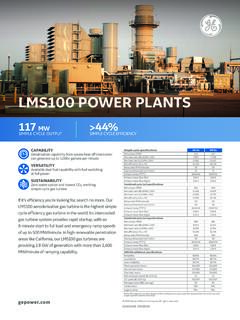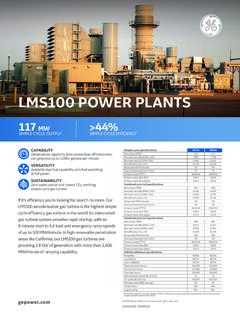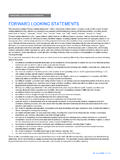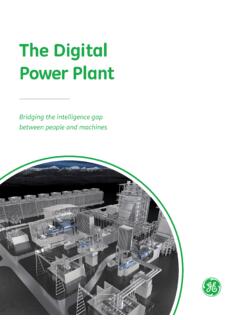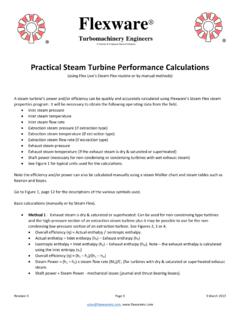Transcription of GER-4190 - Steam Turbine Thermal Evaluation and Assessment
1 GE Power SystemsSteam TurbineThermal Evaluationand AssessmentPaul AlbertGE Power SystemsSchenectady, NYGER-4190gContentsIntroduction.. 1 Baseline and Periodic Performance Testing.. 1 ASME PTC 6S Report .. 2 Capacity Test .. 2 Enthalpy Drop Test .. 3 Evaluation of Performance Data.. 3 Assessment of Turbine Conditions .. 6 Turbine Steam Path Evaluation .. 9 Advanced Method for Assessing Stage Efficiency Losses.. 9 Loss Mechanisms .. 10 Leakage Losses .. 10 Friction Losses .. 11 Aerodynamic Losses .. 12 Losses Due to Changes in Flow Passage Areas .. 13 Steam Path Audit Reporting .. 13 Advancements in the Evaluation and Assessment of Data.. 14 Performance Monitoring .. 15 Plant Evaluations .. 15 Summary.. 16 References.. 16 Acknowledgements.. 16 List of Figures.. 17 Steam Turbine Thermal Evaluation and AssessmentGE Power Systems GER-4190 (10/00)iSteam Turbine Thermal Evaluation and AssessmentGE Power Systems GER-4190 (10/00)iiIntroductionFor a Steam Turbine -generator to operate at itsoptimum level of Thermal performance, it mustachieve a high initial level of performance andmust be able to sustain Thermal performanceover time.
2 This is best achieved by an ongoingprogram of Evaluation and Assessment of ther-mal performance data. This program has athree-fold purpose. The first is to detect deteri-oration in the Thermal performance by trend-ing changes in various performance parame-ters. The second is to identify the cause of per-formance degradation by proper data evalua-tion and interpretation. The third is to developcost-effective solutions to correct operationaland equipment problems, which are contribut-ing to the degradation in Thermal meet these objectives, a Thermal perform-ance program should include the followingessential factors: Obtain baseline performance data onindividual turbines and cyclecomponents during initial operationand after a maintenance outage toestablish a base for identifying specificareas of performance losses Periodic acquisition of repeatableperformance data Proper Evaluation and Assessment ofperformance data so thatdeterioration can be detected, located,trended, and corrected in a cost-effective manner Detailed inspection of andquantification of the expectedperformance recovery fromrestoration of Turbine Steam pathThis paper identifies testing procedures andmonitoring activities that are effective forobtaining and evaluating performance data, with its associated results, will estab-lish accurate trends of various performancecharacteristics.
3 The basic theory of the turbinesteam path flow, pressure, and temperaturerelationships is reviewed to improve under-standing of how these trends can be interpretedand used to locate and identify the cause of theturbine deterioration. Some common causes ofturbine deterioration include deposits, solidparticle erosion, increased clearances in pack-ings and tip spill strips, and foreign object paper also reviews the value of conductinga Turbine Steam path Evaluation to identify thespecific components contributing to the loss inthermal performance. In addition, this inspec-tion can be used to verify the predictions of tur-bine conditions from the monitoring advancements of GE sPerformance Evaluation Services is also and Periodic PerformanceTesting A performance test conducted in accordancewith the ANSI/ASME PTC 6-1996 SteamTurbine Code (Reference 1)is an accuratemethod of establishing the performance of aturbine-generator unit.
4 The test requires theuse of highly accurate calibrated instrumenta-tion and highly controlled measurement proce-dures. When this code is used to conductAcceptance tests, the uncertainty of the testresult is very small. Although this code test pro-vides excellent baseline performance, it gener-ally is not economically justifiable for periodictesting as part of monitoring , the test code is useful in developing abasic understanding of the required measure-ments and procedures for determining the per-formance of a Turbine -generator Turbine Thermal Evaluation and AssessmentGE Power Systems GER-4190 (10/00)1 The value of the analysis of performance testdata greatly depends on the quality of the use of Acceptance test procedures toobtain periodic performance results yields themost accurate test data for analysis and evalua-tion. Fortunately, performance monitoringdoes not necessarily require absolute accuracy,but it demands repeatable data for establishingaccurate trends of various performance charac-teristics so simplified procedures can be PTC 6S Report The ANSI/ASME PTC 6S Report SimplifiedProcedures for Routine Performance Tests ofSteam Turbines (Reference 2)provides guidancein developing procedures to monitor perform-ance.
5 This procedure provides the necessarydata to determine Turbine cycle heat rate, kilo-watt capacity, HP and IP section efficiencies,and Turbine stage pressures and flow essential measurements for ASME PTC 6 SReport tests are shown inFigure 1. For this test,like other heat rate tests, the most importantmeasurements are electrical load and primaryflow, which is usually measured in the feedwaterline. To assure repeatability, the differentialpressure transducer on the primary flow ele-ment should be calibrated prior to the test. Inaddition, mechanical station watthour metersusually have to be read by counting disk revolu-tions to obtain a precise reading of kilowatt out-put. Temperatures and pressures at the inletand outlet of the HP and IP sections should bemade with instruments capable of producinghigh repeatable determination of the turbinecycle heat rate also depends on cycle primary flow is measured in the feedwaterline, any leakage between the flow measure-ment and the Turbine stop valve must be elimi-nated or the test results adjusted , an erroneous measurement of heatrate will be obtained.
6 Steam and water leakageswithin the Turbine cycle do not affect the meas-urement of heat rate, but these leakages cancause a significant loss in the actual heat rateand kilowatt Test When a repeatable measurement of primaryflow cannot be obtained, another practical,effective method of trending the performanceSteam Turbine Thermal Evaluation and AssessmentGE Power Systems GER-4190 (10/00)2 From ReheaterFrom TurbPTTPTTo TurbinePTPTPTPTPTPTTo SteamGeneratorTo SuperheaterPTTTTPTTTTTo ReheaterPPPPTPTTo (Typ.) ^ instrumentation location for a PTC 6S Test - fossil unitGT25647of the Turbine -generator unit is to make period-ic measurements with the Turbine control valveswide open (VWO). This test, usually referred toas a Capacity Test, determines the generatoroutput capacity, HP and IP enthalpy drop effi-ciency, and Turbine stage rare cases, when Steam generator capacitymay be inadequate to drive the unit to a VWOposition at rated pressure, one alternative is toreduce pressure to permit opening all inlet con-trol valves.
7 This procedure is preferred over themore demanding method of accurately repro-ducing positions of partially opened controlvalves or for correcting results for valve Capacity Test, like the simplified heat ratetest, depends on repeatable measurements ofelectrical output and the pressures and temper-atures at the inlet and outlet of the HP and IPturbine sections. Isolation of the Turbine cycle isalso important because it can significantly affectthe electrical output of the Drop Test The Enthalpy Drop Test is used frequently formonitoring Steam turbines. This test involves aminimum number of instruments, but estab-lishes the efficiency of those Turbine sectionsmost susceptible to deterioration. An EnthalpyDrop Test can be conducted on any Turbine sec-tion operating entirely in the superheat region,such as the HP and IP sections of fossil reheatunits and the HP section of automatic extrac-tion units.
8 The pressure and temperature aheadof and at the exhaust of the section being testedmust be measured. The efficiency of the sectioncan then be calculated from the ratio of actualto isentropic enthalpy drop. The Turbine expan-sion line in Figure 2illustrates this measurements required to determine theHP and IP Turbine section efficiencies areshown in Figure 3. Pressure taps and thermo-couple wells should be located ahead of the tur-bine stop valve, ahead of the intercept valve, ineach cold reheat pipe, and in the crossover orlow-pressure section bowl. In the cold reheatpipes, the pressure taps should be near the HPsection exhaust connection, and the thermo-couple wells should be in the horizontal pipeafter the first elbow to ensure good mixingbefore measuring the temperature instrumentation shouldbe used to conduct an Enthalpy Drop Test. Thiswill not only improve the accuracy of the data,but will also detect a faulty temperature meas-urement.
9 When there are two separate steamleads from the boiler to the Turbine , duplicateinstrumentation is recommended in each of Performance DataThe effort of obtaining good repeatable testdata will be lost unless that data is properly eval-uated. The generator output and Turbine cycleheat rate depends on the operating conditionsof the Turbine cycle and the performance of theSteam Turbine Thermal Evaluation and AssessmentGE Power Systems GER-4190 (10/00)3 ENTROPYENTHALPYS aturation LineAEUEE fficiency=PThrottlePHot ReheatAEUEHP SectionP=3 HgPBowlIP SectionLP SectionPCold ReheatFigure Drop Testmany individual equipment components. If thetest results indicate that heat rate has deterio-rated or the maximum electrical capacity of theunit has changed, any of the following condi-tions could be contributing factors: Turbine Steam flow Efficiency of the Turbine Steam path Available energy of the Turbine ( , Steam conditions) Performance and operation of thebalance of plant componentsTo assess the Turbine condition and its contri-bution to any deterioration in Thermal per-formance, output and heat rate must be cor-rected for the influence of two non-turbinerelated factors: (1) the available energy of theturbine and (2) the performance and opera-tion of the balance of plant available energy of the Turbine is affectedby variations in the following operating condi-tions.
10 Throttle pressure Throttle temperature Reheat temperature Reheater pressure drop Condenser vacuumHeat rate and generator electrical output mustbe corrected for these operating conditionsusing correction factor curves normally provid-ed in the unit's Thermal kit. Figure 4is a sampleof a correction curve. Variations in throttlepressure and temperature also change massflow due to their effect on the specific volumeof Steam . This effect is typically combined withthe available energy effect in the relevant cor-rection factors. Keep in mind that these correc-tions also represent an accounting of perform-ance losses due to operating assessing the Turbine condition, it is nec-essary to account for variations in the perform-ance and operation of balance of plant compo-nents, such as feedwater heaters and auxiliaryprocess flows. Every effort should be made toeliminate or minimize flows which might varydue to seasonal changes or other causes.



